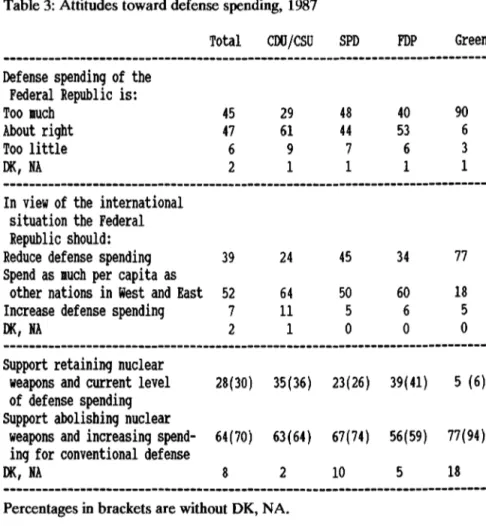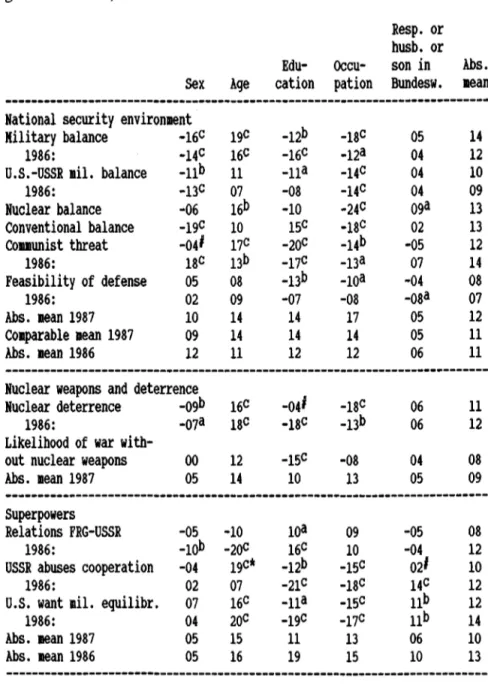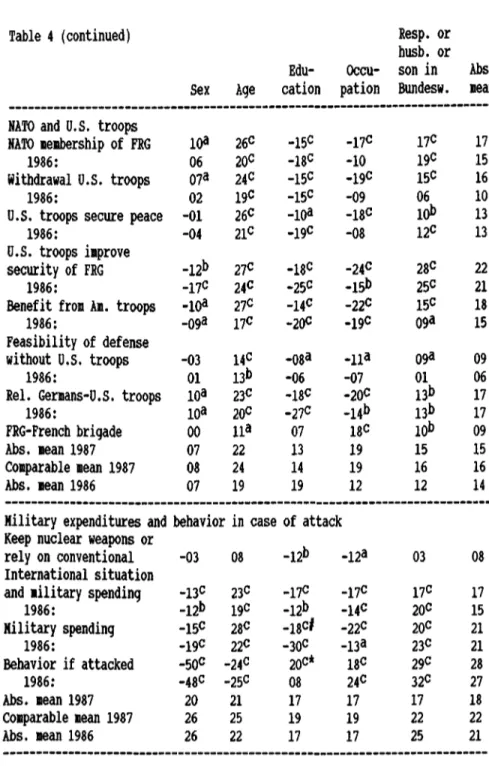THE DEVELOPMENT AND STRUCTURE OF WEST GERMAN PUBLIC OPINION ON SECURITY ISSUES SINCE THE LATE 1970s
Hans Rattinger
t. Introduction
This contribution serves two purposes: First, it examines the development of selected key indicators of public opinion on national security issues in West Germany over the last decade (1978-87). This period includes two years prior to NATO's dual-track decision, the debate over, and the final deploy- ment of new U.S. INF; the road up to the INF Treaty of December 1987;
and the ascent to power of General Secretary Gorbachev in the Soviet Union. If there ever have been major reorientations in West German public opinion on security after the rearmament debate of the 1950s, this is the pe- riod where they most likely must have occurred. Since it is a well-established fact that security-related attitudes in the Federal Republic covary quite strongly with partisan sympathies (Rattinger 1987), changes over time in these associations are also analyzed. The investigation focuses on the fol- lowing aspects of security-related public opinion: perceptions of the Federal Republic's general national security environment (military balance and threat), attitudes toward nuclear weapons and deterrence, evaluations of the superpowers, attitudes toward NATO membership and U.S. forces deployed in West Germany, opinions about military expenditures, and evaluations of the Bundeswehr. Second, we attempt to present some insights on how cur- rent national security attitudes in the Federal Republic are associated with political preferences and social background variables, and to what extent they are interrelated among each other.
The data for this study come from a series of annual surveys conducted for
the Federal Ministry of Defense (see Appendix 1 for a more detailed de-
scription of these surveys). At the time of writing, the original data sets were
not yet accessible, so that only the extensive crosstabulations supplied by the
polling institute could be used. This severely limits the sophistication of data
analysis, of course, and accounts for many of the shortcomings of this effort.
2. Some trends of public opinion
Perceptions of the East-West military balance in the Federal Republic have remained quite stable over the past ten years (Figure 1). Judgments that NATO is superior have fluctuated between 10 and 20 percent, that the Warsaw Pact is superior between 30 and 40 percent, and that both blocs are equally strong between about 40 and 60 percent. If one looks for a substan- tively significant shif t in these perceptions, the most likely candidate is the observation that since 1985 the view that both sides are equally strong has become more frequent than ever before in this ten-year interval, and the view that the Warsaw Pact is superior has correspondingly dropped below previous levels. This could be reversed, of course, as soon as the 1988 sur- vey becomes available. This author would argue, however, that such a reversal is not likely. This shift in 1985 has coincided with the ascent of the new Soviet leadership, and probably reflects improvements in the general climate of East-West relations more than genuine assessments of the military balance.
This argument is supported by the fact that sizeable parts of the public have considerable difficulties in judging relative military strength - which in view of wildly diverging assessments by military "experts" is hardly surprising (e.g., Mearsheimer 1982 and Posen 1988, vs. Karber 1983 and Martin 1983).
In the 1987 survey, respondents were asked four different questions about force comparisons: NATO vs. Warsaw Pact in genera~ regarding conventio- nal forces, regarding nuclear forces, and U .S. vs. USSR in general (in this sequence). Few people had problems commenting on the general East vs.
West and USSR vs. U.S. questions, but 21 percent did not give a judgment on the conventional or on the nuclear balance (Table 1). If one excludes these respondents, the resulting distributions still make some sense along the lines of the widespread notion that Eastem military superiority is parti- cularly acute in conventional forces, while the West still has an edge in nuclear capabilities. The responses to the U.S. vs. USSR question, however, make little sense: With very few refusals, more respondents say that the U .S.
alone is stronger than the USSR ( or at least equally strong) than say so for
NATO vs. the Warsaw Pact. In fact, the Soviet share of total Warsaw Pact
forces is much higher, of course, than the American share of NATO forces,
so that exactly the opposite pattem should be expected.
Figure 1: Which block is stronger?
49
·-NATO + Ma:rs.aw Pac t
"'Both equal
<> DJ<, NA
2Qf---~
Ut
eJ--~~ 8 t 86 r-7 B7
Yea~
Figure 2: Mhich hlock is stronge:r NATO>, by party prererence
<Wa~sawPaot Minus 35
25 :---
15
5
-5
-15 85 86
Yea:r
87
···CDU/CSU +SPD
"' Fl>P
o Green
Table 1: Perceptions of the East-West military balance, 1987
general conventional nuclear u.s.-USSR NATO (U.S.) superior
East (USSR) superior Both equal
DK, NA
32 11 55 2
7 (9) 41 (52) 31 (39) 21
16 (20) 26 (33) 37 (47) 21
14 23 60 3
For complete question wording for this and all subsequent tables and figures see Appendix 2. Percentages in brackets are without OK, NA.
OK, NA: Don't know, no answer
Another interesting observation on perceptions of the military balance con- cerns their distribution by partisan sympathy. That one encounters signifi- cantly more people who claim that the West is superior, and less who say so about the East, as one traverses the political spectrum from right to lef t, has already been reported (e.g., Rattinger 1987, Table 1). However, this polarization along party lines has been reduced in 1987 when compared to earlier years (Figure 2). Adherents of the parties forming the current gov- emment have remained rather stable in their perceptions, but followers of the Social Democrats and of the Greens have become much less likely to claim Western, and much more likely to detect Eastern, superiority. In 1987, SPD voters had become very similar to adherents of the CDU /CSU and FDP in their perception of the military balance, and among Green voters, those believing in Western superiority were almost exactly balanced by those stating that the W arsaw Pact is stronger.
The trend in perceptions of a communist threat is quite similar to that de-
scribed in evaluations of the overall military balance (Figure 3). For 1978 to
1984, the average of an index of threat perception (with minimum 0 and
maximum 3) fluctuated between 1.4 and 1.5. In 1985 it fell to 1.3, and in
1987 it had dropped to below 1.2. Partisan polarization about the extent of a
threat also went down in 1987 (Figure 4): Perception of a communist threat
decreased especially among voters for the SPD and the FDP, whereas for
Green sympathirers it did not decrease further, so that adherents of these
three parties were not far apart in this judgment. Only among CDU /CSU
voters did the group that sees a threat continue to be almost as large as the
one that does not perceive such a threat.
J.,55 J
J.,5 -·-
J.,45
J.,4
J.,35
J.,3
J.,25
J.,2
J.,J.5
J.,J.
78 19
90
80
70
60
X
501 40
30
20
J.0
"
-J.0 .L
85
Figure 3: Perceptfon or COMMUnist
th~eat
(Mean oC index
c~oM9 to 3>
89 8J. 82 83 84
Year
Fl~:ru:':t "c.:p:~e~c 0 e r ~i 0 on 0 : Cl
0c: MtMh"~ei.Stt Minus
<ve~~) st~ong th~eat>~ b~pa~ty p~eCe~ence
_
85
---·
86 87
···CDU/CSU -+-SPD ,,. FDP
<> C.reen
86 Vea:r
87
Unfortunately, this series of studies only contains questions about nuclear dete"ence since 1985. Over these three years, support for nuclear deterrence has fallen slightly to just over 50 percent (Figure 5). This decline has been strongest among Green and SPD voters, who also support immediate abolishment of nuclear weapons more frequently than maintenance of nuclear deterrence. lt should be pointed out, however, that SPD voters still are much closer to voters for the government parties in these views than to adherents of the Greens. lt also deserves mentioning that a substantial share of those who either want nuclear deterrence maintained or nuclear weapons eliminated make this choice under great insecurity over the eff ects of a nuclear-free world. When asked explicitly (in 1987) whether, without any nuclear weapons, war in Europe would become more likely or not, one-third of respondents said they did not know or refused to reply. Among the others, about 60 percent said it would not become more likely (Table 2). If one assumes that those who think that war would be more likely are fully contained among those who want to maintain nuclear weapons and deter- rence, and that those who believe war would not be more likely are fully contained among those who would like to see nuclear weapons abolished, it is obvious that insecurity about the consequences of getting rid of nuclear weapons must be much higher among those who want to maintain nuclear deterrence.
There are several explanations for this observation. First, if one prefers to err on the saf e side, insecurity about the effects of abolishing nuclear weap- ons is more compatible with maintaining nuclear deterrence than with its immediate abolishment. Second, those who want to denucleariz.e imme- diately might have a stronger desire to avoid cognitive dissonance. Third, the
"normative" question about maintaining deterrence vs. eliminating nuclear weapons (which was asked later) is far more "radical" than the "cognitive"
question about what difference these weapons make in terms of war pre-
vention. One thus first finds widespread insecurity and skepticism over
whether nuclear arms really make the decisive difference for war preven-
tion, but when they are later set against the alternative of complete and
quick denuclearization, beliefs that they actually do reduce the likelihood of
war in Europe become much more frequent.
:-.
Fi ~UJ':po5.! t SM?rru°sr t./J:C tni~cnl>•.:·K"t !teat1ero.:;,e; ci:Y ~:~tcye n t proelelt"enoe
5U
3U
iuf „ 1 -J.U
-3U
-5U
-7U 85
6U
5U 4U 3U
82
86 Y•ari
Figure 6: Attitudes toward the U.S. and the USSR
/
83 84 85 86 87
Yea.:r
Total +CDU/CSU
"' ><SPD
<>FDP
* Gx--een
X
87
·•· U wllling to
ai;c.pts. is
Mtli,ta.:ry~ari
t11 oir 1
nCe%'1-1.or1 ty Minus aiMs superoio:rity at
+USS~
is ser1ous ahout
~t~~~t:ill
ahuse
~ff ff;;~ness to
COMP:rOMise
Table 2: Attitudes toward nuclear weapons and deterrence, 1987
Total CDU/CSU SPD FDP Green --- Support nuclear deterrence,
because without nuclear weapons 51 64 45 59 16 likelihood of conventional war
in Europe would be higher
Support i11ediate abolishllent 47 35 54 41 84 of nuclear weapons
DK, BA 2 1 1 0 0
Without nuclear weapons and
deterrence war in Europe would 26(39) 35(53) 20(30) 27(42) 11(13) be 1ore likely
Without nuclear weapons and
deterrence war in Europe would 41(61) 31(47) 46(70) 38(58) 77(87) not be 10re likely
DK, HA 33 34 34 35 12
---
Percentages in brackets are without DK, NA.
Not surprisingly, evaluations of the Soviet Union have changed much more in recent years than the attitudes discussed so far. Figure 6 shows how
"Gorbimania" has brought suspicion vis-a-vis the Soviet Union down quite
dramatically. Up to 1984, skeptical opinions about Soviel intentions out-
numbered positive ones; in 1987, 75 percent were positive. In contrast, the
popular image of the U.S. in the Federal Republic has not changed much,
even though one can be tempted to detect a (much smaller) revival of posi-
tive evaluations in 1987, most likely due to the prospect of the INF agree-
ment and of the resulting removal of the new nuclear weapons stationed in
Europe after 1983. These evaluations of the superpowers have lost some of
their polarization along party lines in recent years. From 1986 to 1987 the
image of the U.S. improved most among Green voters (even though it still is
quite negative), and the image of the Soviet Union improved most among
voters for the governing parties (Figures 7 and 8).
X
Figure 7: Positiue Military Intentions, Minus negative JudgMents on U.S.
~Y pa~typreCerence
.10
-.10
-30
-50
86
Year 87
---0
HI
-.10-~
-301
85 86 87
Vea:r
-•- CDU/CSU
+ SPD
„ FDP
0-Green
CDU/CSU
+SPD
,.. FDP
o- Green
Support for West German membership in NATO has fluctuated between 80 and 90 percent over the past ten years, with a clear but slow downward trend (Ftgure 9). Opposition against the withdrawal of U.S. troops from the Federal Republic has also declined somewhat over the early 1980s, but this has not continued since 1984; opposition now stands at about 75 percent, compared to about 80 percent in the late 1970s. These observations cor- respond, of course, to the decreased sense of Eastem military superiority and of threat, but it should be stressed that up to the mid-1960s, en- dorsement of NATO and of American troop deployment bad been much lower in the Federal Republic than they are now. Partisan disagreement on these issues continues to be very strong and stable: In 1987, 94 percent of CDU/CSU voters favored continuing West German membership in NATO, and 89 percent were opposed to withdrawal of U.S. troops. Corresponding figures for FDP adherents were 98 and 79 percent, 85 and 74 percent among SPD sympathizers, and 41and24 percent, respectively, for Green partisans.
With the exception of a small "shock" in 1980 - probably due to the Soviet invasion in Afghanistan - attitudes toward West German defense spending confirm what we have seen so far (Figure 10). The view that the Federal Republic spends too little has declined somewhat, and clearly is held by a small minority. The opposite view has risen from below 30 to over 40 per- cent, and the notion that military expenditures are adequate has fallen from somewhat below 60 to under 50 percent. Partisan polarization over this mat- ter is strong and stable (Figure 11). SPD adherents are about evenly split among the views that these outlays are insufficient or adequate, on the one band, and exaggerated, on the other. Green voters overwhelmingly hold the latter opinion, and voters for the govemment parties are least opposed to current levels of defense spending. As can be seen in Figure 11, the shift in the aggregate distributions over the past three years toward more skepticism vis-a-vis West German military expenditures was mainly due to Green and FDP voters. The former have moved even further away from the sym- pathizers of the "established" parties over this issue, and the latter have now become more similar to SPD than to CDU /CSU voters.
But these judgments about the size of the West German military budget ob-
viously are quite unstable ones for some respondents. When, in 1987, they
were asked (immediately preceding the question about too high, too low, or
adequate) whether - given the present international situation - the Federal
Republic should spend less on defense, more, or as much per capita as other
Western and Eastem nations, the latter response was chosen by more people
than the view that defense spending is "about right," and the opinion that it
Figure 9: Attitudes toward NATO and U.S. troops
]_/
85
811
75
711+-~~+-~--1~~-1-~~-1-~~-4-~~-1-~~1--~--1~~-l
78 79 811 81 82 83 84 85 86 87
Year-
Fisure ie: Attitudes
towa~dWest GerMan deCense spending 611
·- Too 9'uch -+- About right ,.. Too little o DJ<, HA
Veazm.
should be reduced was less frequent than that the Federal Republic was spending "too much" (Table 3). These discrepancies were weakest for CDU/CSU voters, and strongest for adherents of the Greens. Of course one could argue that this category of "as much as others" can be interpreted at will. Those who want reductions might think of Denmark or Luxembourg;
those who want increases might use the superpowers as points of reference.
However, such respondents could have simply and directly said that they fa- vored reductions or increases, as these answers were also offered. There- fore, "as much as others" probably serves as an intermediate category equiv- alent to "about right." But if that is so, it is puzzling that it is chosen more often, and reductions are less frequently advocated, if people are reminded of the international situation and of others' behavior.
Another indication of how insecure people are in their views on military ex- penditures is found in the responses to a question also asked in 1987 (pre- ceding the above two items), whether nuclear weapons and current levels of defense spending should be maintained, or whether nuclear weapons should be eliminated and defense spending be increased as compensation (Table 3).
In contrast to the other two questions, there were some refusals and "don't knows," but the surprising fact is that almost two-thirds (even 70 percent of those with an opinion) preferred the combination of denuclearization of Western defense with increased military expenditures. The majority in favor of this combination was smallest among FDP voters, but SPD and Green voters, who otherwise have the most reservations about defense spending, were most willing to accept it. We thus have the striking fact that 90 percent of Green voters believe that West German military expenditures are too high, but 77 percent of them (94 percent of those with an opinion) at the same time want to spend even more, in order to see nuclear weapons elimi- nated. Even though 18 percent of the Green voters did not respond to this question (probably because they think that denuclearization and cuts of de- fense expenditures should both be achieved), the anti-nuclear affect seems to be much stronger than their opposition to the present level of West German defense outlays.
Attitudes toward the Bundeswehr, finally, have changed only little over the
past decade (Figure 12). Between 85 and 90 percent of samples have con-
sistently endorsed the view that its existence makes peace more secure,
rather than being a threat to peace. Only a small realignment of about three
percentage points seems to have occurred, if the earlier and later years
within this ten-year interval are compared, and this is almost exclusively due
to the growth of the Green electorate. Among CDU /CSU and FDP voters,
:;:
:;:
60T
··t 20
••• CDU/CSU
0 +SPD
„ FDP
-20
-40
-60
-801 85 86 ,,________„ 87
Yea.r
Flgure J.2: Attitudes towaX'd the Bundeswel•X' 90 -=--·---·--- ...__,, ___________ _
80
70
69
59
49
39
29
J.9 +-+--- __....
)l<-->K----. 1 )1(
1 *----~*--*----*----*-->K---- 9 78 79 1 89 1 8J. 1 82 1 03 1 84 1 85 1 e6 1 e'7 1
Year
·•· Bundesweh:r Makes peace Mo:re secure + Bundeswehr is dangerous
ror peace
„ J>K, HA
Table 3: Attitudes toward defense spending, 1987
Total CDU/CSU SPD FDP Green Def ense spending of the
Federal Republic is:
Too much 45 29 48 40 90
About right 47 61 44 53 6
Too little 6 9 7 6 3
DK, NA 2 1 1 1 1
In view of the international situation the Federal Republic should:
Reduce def ense spending 39 24 45 34 77
Spend as much per capita as
other nations in West and East 52 64 50 60 18
Increase def ense spending 7 11 5 6 5
DK, NA 2 1 0 0 0
--- Support retaining nuclear
weapons and current level 28(30) 35(36) 23(26) 39(41) 5 (6) of def ense spending
Support abolishing nuclear
weapons and increasing spend- 64(70) 63(64) 67(74) 56(59) 77(94) ing f or conventional def ense
DK, NA 8 2 10 5 18
---
Percentages in brackets are without DK, NA.
evaluations of the Bundeswehr as dangerous for peace are very rare, and
only about 10 to 12 percent of SPD followers hold this opinion. Green vot-
ers, however, usually are about evenly split over this issue of whether the
existence of the Bundeswehr is good or dangerous for the preservation of
peace. Apart from this segment of the electorate, the Bundeswehr thus has
come through the turmoil of the 1980s without any damage to its general ac-
ceptance in West German public opinion.
3. The structure of public opinion 3.1. Covariation with social background
We now turn to the second set of main questions of this contribution, i.e., how public opinion on national security issues in the Federal Republic is re- lated to social background variables and to partisan pref erences of re- spondents, and what interrelations among these attitudes can be observed. In contrast to the previous section, we will here draw on the full range of items asked in the 1987 survey. In addition, we will compare the findings for 1987 with those for 1986, whenever a question was included in both years. The strength of these associations (Tables 4 and 5) is measured by Pearson's contingency coefficient C, adjusted for degrees of freedom (see note to Table 4).
As social background variables, sex, age, education, occupation, and inf or- mation about whether the respondent himself (or husband or son) currently is ( or has been) in the Bundeswehr are available. With these five variables and 33 questions, a total of 165 associations are reported in Table 4 for 1987. One hundred twenty one out of these (i.e., almost three out of four) are significantly different from zero. With a sample size of almost 2,000, this is hardly surprising, of course, as sometimes ( depending upon degrees of freedom) even adjusted C-values as low as .08 already qualify for statistical significance.
In terms of absolute magnitude, however, the associations reported in Table
4 between national security attitudes and the positions of respondents in the
social structure generally are low to very low. Their overall absolute mean
for 1987 is .14. Answers to these 33 questions about national security issues
appear to be related most strongly to age and occupation (with average
absolute C of .18 and .17, respectively). The older respondents are, the more
they tend tobe in favor of military defense, the Western alliance, the Bun-
deswehr, etc. (see the notes to Table 4 for the coding of the "direction" of
variables). Self-employed respondents and public servants tend to be most
skeptical vis-a-vis defense matters, and blue-collar and white-collar em-
ployees are least skeptical, with retired respondents usually in between. With
C = .14, education follows next, skepticism and opposition growing with
length of education. Direct or indirect experience with the Bundeswehr
Table 4: Associations between national security attitudes and social back- ground variables, 1987 and 1986
Resp. or husb. or Edu- Occu- son in Abs.
Sex Age cation pation Bundesw. mean
---
National security environment
-12b
Military balance -16c 19C -13c 05 14
1986: -14C 16C -16c -12a 04 12
U.S.-USSR mil. balance -11b 11 -11a -14C 04 10
1986: -13C 07 -08 -14C 04 09
Nuclear balance -06 16b -10 -24c 09a 13
Conventional balance -19c 10 15c -13c 02 13
Communist threat -04# 11c -2oc -14b -05 12
1986: 18c 13b -17C -13a 07 14
Feasibility of defense 05 08 -13b -10a -04 08
1986: 02 09 -07 -08 -03a 07
Abs. mean 1987 10 14 14 17 05 12
Comparable mean 1987 09 14 14 14 05 11
Abs. mean 1986 12 11 12 12 06 11
---
Nuclear weapons and deterrence
-04#
Nuclear deterrence -09b 16C -13c 06 11
1986: -07a 18c -13c -13b 06 12
Likelihood of war with-
out nuclear weapons 00 12 -15c -08 04 08
Abs. mean 1987 05 14 10 13 05 09
---
Superpowers
Relations FRG-USSR -05 -10 1oa 09 -05 08
1986: -1ob -2oc 16c 10 -04 12
USSR abuses cooperation -04 19C* -12b -15c 021 10
1986: 02 07 -21c -13c 14c 12
u.s. want mil. equilibr. 07 16c -11a -15c 11b 12
1986: 04 2oc -19c -17C 11b 14
Abs. mean 1987 05 15 11 13 06 10
Abs. mean 1986 05 16 19 15 10 13
---
Table 4 (continued) Resp. or husb. or Edu- Occu- son in Abs.
Sex Age cation pation Bundesw. mean --- NATO and u.s. troops
NATO 1ellbership of FRG 10a 26c -15c -17C 17c 17
1986: 06 20c -18C -10 19c 15
Withdrawal U.S. troops 07a 24c -15c -19c 15c 16
1986: 02 19c -15C -09 06 10
u.s. troops secure peace -01 26c -1oa -18C 1ob 13
1986: -04 21c -19c -08 12c 13
u.s. troops improve
-12b
security of FRG 27c -13C -24C 28C 22
1986: -17C 24c -25c -1sb 25c 21
Benef it from Am. troops -10a 27c -14C -22c 15c 18
1986: -09a 17C -2QC -19c 09a 15
Feasibility of defense
without u.s. troops -03 14c -03a -11a 09a 09
1986: 01 13b -06 -07 01 06
Rel. Germans-u.s. troops 1oa 23c -18C -2QC 13b 17
1986: 1oa 20c -27c -14b 13b 17
FRG-French brigade 00 11a 07 13C 1ob 09
Abs. mean 1987 07 22 13 19 15 15
Comparable mean 1987 08 24 14 19 16 16
Abs. iean 1986 07 19 19 12 12 14
--- Military expenditures and behavior in case of attack
Keep nuclear weapons or
-12b
rely on conventional -03 08 -12a 03 08
International situation
and 1ilitary spending -13C 23C -17C -17C 17C 17
1986: -12b 19c -12b -14C 2oc 15
Military spending -15c 23c -13c# -22c 20c 21
1986: -19c 22c -30C -13a 23c 21
Behavior if attacked -5oc -24c 20c* 13c 29c 28
1986: -43C -25c 08 24c 32c 27
Abs. mean 1987 20 21 17 17 17 18
Comparable 1ean 1987 26 25 19 19 22 22
Abs. mean 1986 26 22 17 17 25 21
---
Table 4 (continued) Resp. or husb. or Edu- Occu- son in Abs.
Sex Age cation pation Bundesw. 11ean
---
Bundeswehr
Interest in Bundeswehr -4oc -1oa 21c 11a 15c 19
1986: .31c -19c 19c 14b 15c 20
Bundesw. good for peace 00 27c .14c 19c 2oc 16
1986: -05 20c -21c 09 21c 15
ArllS of Bundesw. suffic. -06 07 -06 -1oa -02 06
1986: -07a 09 -14C -05 07a 08
Training and leadership
of Bundesw. sufficient 07 22c -18c -17C 06 14
1986: 11a 13a .17C -11 12b 13
Evaluation of voluntary
-26c*
11ilitary service -14C 34C -22c 21c 25
1986: -10 27c -24c -15b 3oc 21
Eval. of draft resisters 14C -29c 1sbl 21c -29c 23
1986: 17c -22c 2~ 21c -21c 22
Kanpower problems of
Bundeswehr are serious 05 26c .17c 19c 16c 17
1986: 04 24c -21c 13a 17C 18
Association of Bundes-
wehr with parties 15c 09 -15c# -13b 04 11
1986: 16C 19c -29c -22c 12b 20
Abs. aean 1987 13 21 16 18 15 17
Abs. 11ean 1986 13 19 22 14 17 17
---
Peace 1ove11ent
Esti1ated popular support 11a -1sb 07 08 11a 10
1986: 13b -21c 1sb 17c -13b 16
Goals of peace movementd 12a 16c 14a 19c 10 14
1986: 17C 22c 16C 15a 16C 17
Abs. 1ean 1987 12 16 11 14 11 12
Abs. 11ean 1986 15 22 16 16 15 17
---
Overall abs. aean 1987 10 18 14 17 12 14
Co11p. overall aean 1987 11 19 14 17 13 15
Overall abs. 11ean 1986 12 18 18 14 14 15
---
Notes to Table 4
Cell entries are Pearson's contingency coefficients C, i.e.:
chi2 C=(---)1/2
chi2+N
corrected for degrees of freedom (so that the maximum value always is 1) by dividing by the theoretical maximum of C, i.e.
min(rows, colUJms)-1 (---)1/2
1in(rows, columns)
They have been multiplied by 100 to avoid the decimal point. Significances reported are those of the corresponding chi2 values.
By convention, C is positive. However, in order to make the directions of associations visible, signs have been assigned here by assuming variables to be "ordinal". Their "positive" or "upper" ends have been assumed as follows:
Sex: female Age: older Education: longer Occupation: white collar
Respondent or husband or son has been or is in Bundeswehr: yes
Military balance, U.S.-USSR military balance, Nuclear balance, Conven- tional balance: East superior
Communist threat: high Feasibility of defense: unlikely Nuclear deterrence: acceptance
Likelihood of war without nuclear weapons: higher Relations FRG-USSR: will improve
USSR abuses cooperation: yes V .S. want military equilibrium: yes NATO membership of FRG: favor Withdrawal of V .S. troops: opposed U.S. troops secure peace: agreement
U.S. troops improve security of FRG: agreement Benefit from U.S. troops: for FRG
Feasibility of defense without U.S. troops: unlikely Relations Germans-U .S. troops: good
FRG-French brigade: favor
Keep nuclear weapons or rely on conventional: nuclear
Notes to Table 4 (continued)
International situation and military spending: higher spending Military spending: higher spending
Behavior if attacked: resist Interest in Bundeswehr: high
Bundeswehr good for peace: agreement Arms of Bundeswehr sufficient: disagreement
Training and leadership of Bundeswehr sufficient: agreement Evaluation of voluntary military service: positive
Evaluation of draf t resisters: positive
Manpower problems of Bundeswehr are serious: agreement Association of Bundeswehr with parties: Bundeswehr independent Estimated support for peace movement in population: high a: p<.05
b: p<.01 c: p<.001
d: No direction could be assumed for this variable
*:More than .1strongerin1987
#: More than .1 weaker in 1987
ranks fourth (C=.12); generally such contact is associated with more fa- vorable views on military defense. The weakest relationship of these opin- ions exists with sex (C=.10); usually women can be seen tobe a little more skeptical than men.
If one compares the strength of associations across groups of items, one
finds that they are strongest for attitudes on military expenditures and on
behavior in case of an attack (the mean absolute Cis .18). In this group of
questions, relations with all five background variables are about equally
strong, whereas in all other groups of items the relations with age and occu-
pation are strongest, and those with sex and experience with the
Bundeswehr are weakest. lt is also in this group that one finds one of the
few really strong relationships documented in Table 4, i.e., between sex and
responses to how one would personally behave in case of a military aggres-
sion against the Federal Republic. Not surprisingly, males are far more likely
than females to say that they would fight or somehow resist.
Questions about the Bundeswehr follow second in the strength of their asso- ciation with respondents' social background. Within this group two more remarkably strong coefficients occur. One is between sex and interest in matters relating to the Bundeswehr, where we find women (who are more critical of defense matters, as we have seen) substantially less interested (C=.40). The second is between age and evaluations of men who voluntarily join the Bundeswehr; here we discem that such evaluations get noticeably better the older respondents are (C = .34). In all other five categories of questions, not a single contingency coefficient above .30 can be found. By average strength of associations, their rank order is: attitudes on NATO and U.S. troops (.15), on the national security environment and on the peace movement (both .12), on the superpowers (.10), and, finally, on nuclear weapons and deterrence (.09).
Only a few of the coefficients reported in Table 4 do not conform to the general covariations summarized above, i.e., that men, older respondents, people with less education, blue-collar or white-collar employees, or re- spondents with experience with the Bundeswehr tend to hold more favor- able views toward military defense. Most noteworthy among these "excep- tions" are the following observations: better educated respondents, even though they are less likely to concede Eastem military superiority than others in general terms, are more prone than others to recognize Warsaw Pact conventional superiority. These better educated people also deviate from their otherwi~ predominant pattems of attitudes in that they are more willing than others to fight in case of an aggression against the Federal Re- public; the same deviation occurs among self-employed respondents and public servants. Regarding interest in matters conceming the Bundeswehr, several relations with social background variables are reversed against the predominant pattems. Those who have experience with the Bundeswehr are more interested and are generally more favorably inclined toward security issues; women are much less interested than men and are less favorable in their views. But for the other three background variables we find that those groups of respondents with stronger pro-def ense, etc., opinions tend to be less interested in these issues, and vice versa. Finally, women depart from their otherwise less positive attitudes toward the Bundeswehr by being more willing than men to describe it as independent from West German political parties.
For those questions that have been asked both in 1986 andin 1987, Table 4
shows that associations of national security opinions with social background
variables have been rather small, but quite stable. The average absolute val-
ues of C in both years look very similar, regarclless of whether one averages by survey question or by background variable. Changes of sign from one year to the next have occurred only for insignificant coefficients. Only in nine cases does the difference between 1987 and 1986 exceed .10. Five of these cases involve education, where once there was an increase of more than .10, and four coefficients decreased by more than that amount, which leaves the impression that a slight decline of the importance of education has been the major change between these two years in terms of how national security attitudes were associated with social background variables.
In summary, we can say that these opinions in the Federal Republic do in fact differ between socially defined groups, and that many of these associa- tions correspond to widespread notions, particularly those involving age and education. We can also say that these covariations are quite stable, at least in the short run. However, apart from a few exceptions, their magnitude is not very impressive, even for age. lt has been demonstrated various times that national security attitudes in West Germany, of all commonly used social characteristics, covary most strongly with age (Rattinger 1985, 1987; Rattin- ger and Heinlein 1986). The same finding has emerged here. But the moder- ate strength of these relationships does not support the notion that genera- tional succession is the most important factor for aligning these opinions in the Federal Republic, at least not at the level of the mass public (for a contrary view see Szabo 1983, 1984).
3.2. Covariation with partisan preference
Turning now to the connection between security-related attitudes and parti- san preferences (Table 5, last column), we discem the familiar fact that these are much stronger, with an absolute average contingency coefficient of .34. Without exception, these coefficients are significantly different from zero, and, without exception, their signs are as one would predict from the simple argument that views on military security get less and less favorable as one travels across the political spectrum from "right" to "left," which in the West German case means from the CDU/CSU via the FDP and the SPD to the Green party.
With an average absolute C of .47, attitudes on NATO and U.S. troops de- ployed in the Federal Republic covary most strongly with party preferences.
Such associations are highest with respondents' positions on whether these
forces should be withdrawn, and on whether or not their deployment makes peace more secure. Opinions on nuclear weapons and deterrence rank sec- ond in partisan polarization. Evaluations of military expenditures and of the Bundeswehr come next (both with mean absolute C of .33). The strongest partisan disagreements here occur about the size of the West German de- fense budget, the evaluation of men who voluntarily serve in the armed for- ces, and about whether or not the existence of the Bundeswehr makes peace more secure. Opinions about the superpowers are polarized by party below average (mean absolute C of .29), but the trustworthiness of the Soviet Union is judged quite differently by the various partisan groups. Perceptions of the national security environment and attitudes toward the peace move- ment are least dissimilar between groups of partisans (with mean absolute C of 21 and .20, respectively). Within the first group of survey questions the strongest partisan disagreement exists over the extent of a communist threat for the Federal Republic (C=.36).
Changes between 1986 and 1987 are minimal; for comparable items the average absolute contingency coefficient was higher in 1987 than in 1986 by .02. Only for three variables does the difference of C between these two years exceed .10: polarization over whether U.S. forces in Europe make peace more or less secure and of interest in the Bundeswehr and related matters has increased more than this amount, and it has fallen by more than .10 over whether or not the Bundeswehr has a special affiliation with one of the West German parties.
3.3. Covariation among attitudes on security
The final step of this analysis is to look at some interrelations among nation- al security attitudes. As the data is very limited here, no complete matrix of covariations can be presented, and nothing even resembling a standard fac- tor analysis can be performed. Only crosstabulations of all survey questions with three selected items were available: the extent of communist threat, po- sitions on U .S. withdrawal, and opinions about the effects of the existence of the Bundeswehr for peace. But even with this limited set of data some im- portant observations can be recorded (Table 5, first Cour columns).
In the average, the results for the 1987 survey questions are as strongly as-
sociated with these three items as with partisan sympathies (mean absolute
C of .34). The highest contingency coefficients again occur in the group of
Table 5: Associations among national security attitudes, and between na- tional security attitudes and party preference, 1987 and 1986
Peace
1ore Abs.
secure mean
Cou. u.s. throuqh col.
threat withdr. Bundesw. l-3e Party
--- National security environ1ent
Military balance 29c 21c 24C 25 19c
1986: 34C 29c 20c 28 23c
u.s.-USSR military balance 23c 09a# 11c 16 21c
1986: 26c 2oc 16c 21 15c
Nuclear balance 30C 23c 28c 27 20c
Conventional balance 27c 19C 23c 23 17C
ColllUilist threat looc 33C 18c 26 36c
1986: looc 29c 27c 28 35C
Feasibility of defense 26c 03 00 10 13b
1986: 28c 00 03 10 09a
Abs. aean 1987e 27 18 18 21 21
Comparable mean 1987e 26 17 15 19 22
Abs. mean 1986e 29 20 17 22 21
---
Huclear weapons and deterrence 39C*
Huclear deterrence 40C 34C 38 39C
1986: 27c 35c 36c 33 34C
Likelihood of war without
nuclear weapons 47c uc 20c 36 39C
Abs. mean 1987 43 41 27 37 39
---
Superpowers
-34c*
Relations FRG-USSR -14C -13C 20 -20C
1986: -19c -18c -22c 20 -14b
USSR abuses cooperation 61C 23c 16c 35 33C
1986: 54C 26C 21c 34 44C
u.s. want milit. equilibrium 21c 43C uc 35 30C
1986: 25c 48C 34C 36 32c
Abs. aean 1987 39 28 23 30 29
Abs. tean 1986 33 31 26 30 30
---
Table 5 (continued) Peace
more Abs.
secure mean CoJDll. u.s. through col.
threat witbdr. Bundesw. 1-3e Party --- NATO and U.S. troops
NATO membership of FRG 25c 71c 71C 56 5oc
1986: JlC 66C 71C 56 49c
Witbdrawal of u.s. troops 34c 10oc 53C 46 56C
1986: 2sc 1ooc 53C 41 43C
u.s. troops secure peace JlC soc 69c 60 6oc*
1986: 33C 76C 64c 58 49C
u.s. troops improve
security of FRG 39C 35C 1oc 65 52c
1986: 41c 33c 73c 66 50c
Benefit from u.s. troops 32c soc 61C 58 44C
1986: 3oc sie 6QC 57 42c
Defense without u.s. troops 24c 49C 22c 32 36C
1986: JlC 49C 26C 35 29c
Relations Germans-u.s. troops 26c 49C 43c* 39 37C
1986: 22c 53c 32c 36 29c
FRG-French brigade 15c 33C 21c 23 44C
Abs. 11ean 1937e 28 64 52 47 47
Comparable mean 1937e 30 69 56 51 47
Abs. mean 1986e 31 68 54 50 42
--- Military expenditures and bebavior in case of attack
Keep nuclear weapons or
rely on conventional 26c 26C 11c 23 27c
International situation
and military spending 5oc* 53C* 43C 50 33c
1986: 33c 47c 4oc 42 44c
Military spending 41C 62C 53C 54 44c
1986: 35C 56C 63C 51 46C
Bebavior if attacked 27c 4oc* 2sc 32 23c
1986: 19c 26c 25c 23 JlC
Abs. mean 1987 36 47 37 40 33
Comparable mean 1987 39 54 44 45 35
Abs. mean 1986 31 43 43 39 40
---
Table 5 (continued) Peace
more Abs.
secure mean
Cou. u.s. through col.
threat withdr. Bundesw. 1-3e Party --- Bundeswehr
Interest in Bundeswehr 25c* 13c 13C 17 27c*
1986: 14C 15c 14C 14 ua
Bundeswehr good f or peace 17c 53C 1ooc 38 47C
1986: 26C 54C 1ooc 40 52c
Arms of Bundesw. sufficient 33c 17C 12c 22 15c
1986: 33c 12c 10b 20 12b
Training and leadership
19c#
of Bundeswehr suff icient -na 27c 19 19c
1986: -16c uc 37C 31 23c
Evaluat. of military service 32c 63C* 53c 51 51c
1986: 23c 49C 51c 43 45C
Evaluat. of draft resisters -JlC -41C -45c 39 -42c
1986: -JQC -4oc -4oc 37 -36C
Hanpower problellS of
Bundeswehr are serious 33C 65c 43C 50 44c
1986: 37c 62C 5oc 50 43C
Association of Bundeswehr
with parties 09 JQC 24c# 21 21c#
1986: 11c 35C 33C 30 33C
Abs. 11ean 1937e 25 38 32 32 33
Abs. mean 1986e 26 39 34 33 33
--- Peace movement
Estimated popular support -13c -17C -13c 18 -19c
1986: -15c -26c -20C 20 -24c
Goals of peace movementd 27c 16c na 18 21a
1986: 24c 21c 09a 18 2sc
Abs. mean 1987 23 17 15 18 20
Abs. mean 1986 20 24 15 19 26
---
Overall abs. mean 1987e 30 39 33 34 34
Comp. overall mean 1987e 30 41 35 35 35
Overall abs. mean 1986e 28 41 35 35 33
---
Notes to Table 5
Cell entries are defined as in Table 4. CDU /CSU-voters have been assumed tobe at the "positive" or "upper" end of partisanship.
a to d: as for Table 4
e: "Main diagonal" associations ( C = 100) are excluded from means
*:More than .1strongerin1987
#:More than .1weakerin1987
questions about NATO and U.S. troops (.47 average). Not surprisingly, questions about West German membership in NATO, whether U.S. forces in Europe make peace more secure, whether they improve the security of the Federal Republic, and about who benefits from their presence, all are particularly strongly related to positions on the withdrawal of these forces (C-values over .70). Moreover, answers to these four questions also are strongly associated with judgments on whether or not the Bundeswehr makes peace more secure (C-values above .60). Opinions about the military budget and statements about respondents' behavior if the Federal Republic came under attack are also quite strongly related to attitudes toward these three items, with an average C of .40. Several coefficients exceed .50, and the covariation is highest with positions about U.S. withdrawal.
Next in intensity of relations with these three questions comes the group of
items on nuclear weapons and deterrence (.37 average). Estimates about the
likelihood of war without nuclear weapons are particularly strongly related
to judgments about the extent of a communist threat (C=.47). With a mean
absolute C of .32, attitudes toward the Bundeswehr are roughly average in
terms of being associated with other items. Tue highest coefficients (all
above .50) here occur between evaluations of voluntary military service and
judgments of whether or not the Bundeswehr makes peace more secure, and
between attitudes on the withdrawal of U.S. forces, on the one band, and
evaluations of the Bundeswehr, of its manpower problems, and of voluntary
military service, on the other band. Attitudes toward the superpowers, per-
ceptions of the national security environment, and evaluations of the peace
movement are related to these three items on communist threat, U.S. forces,
and the Bundeswehr least strongly (average absolute C of .30, .21, and .18,
respectively). The strongest single covariations here are between perception
of communist threat and suspicion of Soviel motives ( .61 ), between opinions
about U.S. withdrawal and suspicion of American motives (.43), between perception of communist threat and opinions about U.S. withdrawal (.33), and between perceptions of the nuclear balance and of communist threat (.30).
Again there are no major changes in these structures of attitudes between 1986 and 1987, as far as comparable data are available. Eight coefficients have grown by more than .10, and three have fallen by more than that amount between these two years. All four such changes involving percep- tions of communist threat are upward, and the mean absolute covariation of this variable with all repeated survey questions has increased from .28 to .30, so that one could speculate that the role of such perceptions in shaping national security attitudes has become a little more important.
These findings, limited as they are, need to be interpreted in at least two in- terrelated respects: first, what do they teil us about any underlying attitudi- nal structure that can explain the responses to individual survey questions, and, second, do they reflect a high degree of attitudinal constraint in the mass public's views on these issues? Both of these questions cannot be an- swered quite satisfactorily, due to the limitations of the available data, so that only some preliminary speculations can be offered.
As to the first point, it is useful to conceive of the survey items, which in Tables 4 and 5 have been organized according to the objects of opinions, as being representative of a few hierarchically interrelated more general con- cepts (see Hurwitz and Peffiey 1987, for an excellent analysis along these lines). Figure 13 represents such an attempt for the 1987 data. The attitades included in this figure fall into four broad categories: perceptions of the se- curity environment of the Federal Republic and of the superpowers (judg- ments about the military balance and about communist threat, suspicion of Soviet and trust in U.S. intentions); attitudes on deterrence and defense as very general approaches to provide security; evaluations of the concrete
"organizational" implementation of deterrence and defense (NATO, the
Bundeswehr, and the U .S. military presence ); and opinions about the opera-
tional implications of this organizational setup ( military service and defense
expenditures). The criterion for selecting individual survey items for inclu-
sion in this diagram is whether they stand in a particularly strong relation-
ship with other items, or whether there is a noteworthy absence of associa-
tions.
Figure 13: Selected hierarchical associations among national security atti- tudes, 1987 (contingency coefficients C from Table 5, as defined in note to Table 4)
1---.21---1
1 1
Kilitary--~.29---Colllluniat---.61---suapicion
Trust
balance threat ot USSR in u. s.
1---.21--->I 1--.39-->I
V V
1 <---1 Raliance on Reaist .43
1 deterrence aqgression
1--.40-->I 1<---.34---1--1---1
1 1---.40---1--->I
.17 !---. 34---1---> 1 1---.2s---->I
1 <---.
2a---1---1
1 1
V V V Bundeswehr
V
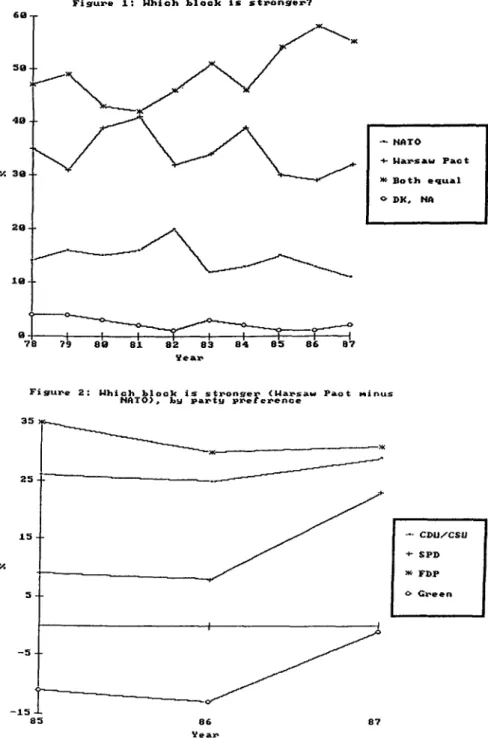
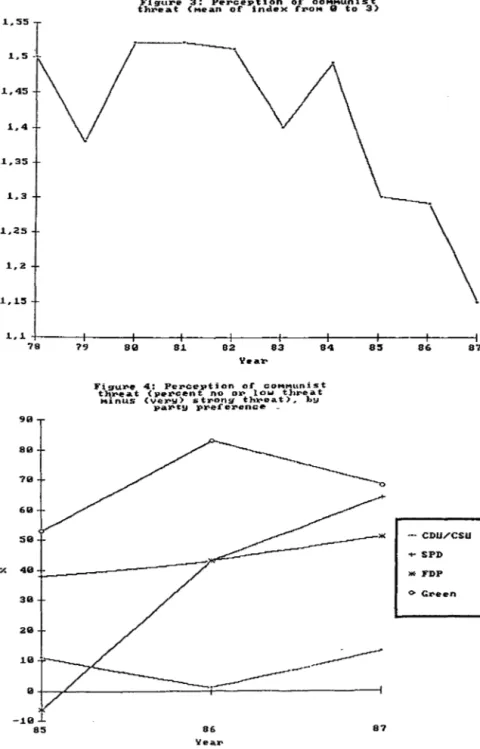
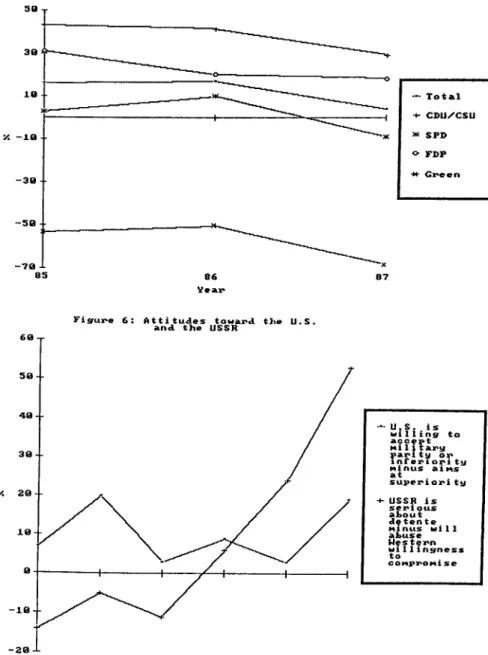
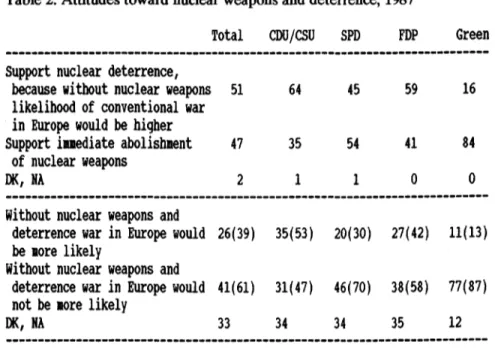
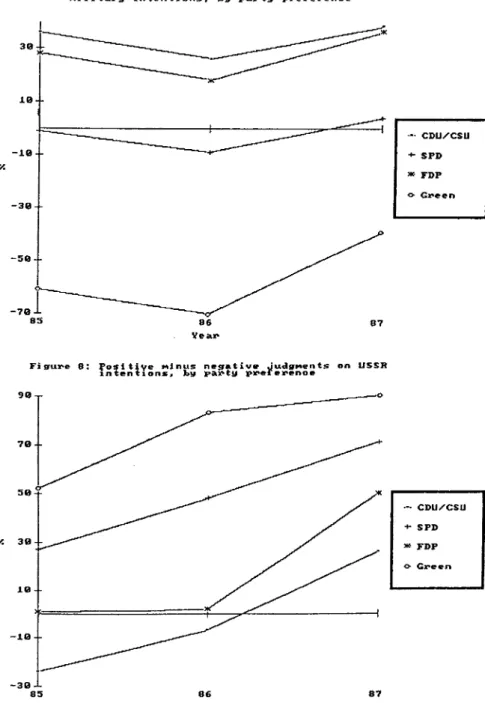
![Figure 9: Attitudes toward NATO and U.S. troops ]_/ 85 811 75 711+-~~+-~--1~~-1-~~-1-~~-4-~~-1-~~1--~--1~~-l 78 79 811 81 82 83 84 85 86 87](https://thumb-eu.123doks.com/thumbv2/1library_info/3867650.1518616/11.584.65.553.87.479/figure-attitudes-nato-u-s-troops-l.webp)
